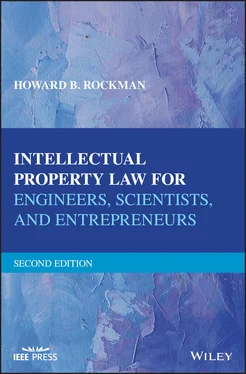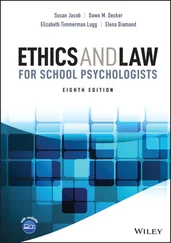There are many articles and books written about Babbage’s work and how his difference engine operates. Those of you who are interested in delving into this subject matter further are encouraged to review the literature and gain more information about the earliest computer ever made from these sources, several of which are named in the Bibliography section of this text.
1 Overview of Intellectual Property Law
1.1 DEFINING “INTELLECTUAL PROPERTY”
First, we need to define the core term of our subject: intellectual property . The term “intellectual property” generically describes those “intangible” property rights—those you usually cannot see or touch—which are initially created by one’s intellectual creative efforts. The results of those intellectual efforts, in most cases, are then anointed with these intangible property rights that give their creator or owner the “exclusive” ability to control, and profit from, the results of this creativity. “Intellectual Property Law” is that field of law which defines those intellectual creations that are entitled to protection as intellectual property, how to obtain (or lose) those intellectual property rights, how to properly use and benefit from those rights, and how to obtain enforcement and compensation when those intellectual property rights are infringed upon by a competitor or other evil person. Intellectual Property Law also provides guidance to a competitor who desires to produce a new product or use a new process, by designing around, and thus avoiding, the proprietary territory defined by your intellectual property rights.
Winning or losing out in business and financial opportunities many times heavily depends upon whether your creative output, inventions, products and business ideas and services are protected by patents, trademarks, copyrights, trade secret rights, mask work rights, and others. Commercially new and useful ideas, inventions, products, and business services are the foundation of practically every highly successful business. As a result, successful business owners and entrepreneurs typically place a high value on the exclusive rights granted to intellectual property developed by their employees.
Businesses have succeeded or failed because of their owner’s efforts to protect their intellectual property, or their failure to do so. The value of many publicly traded companies has taken huge swings based principally upon whether the company has been successful in obtaining and enforcing its patent rights, for example. There are many common myths and misunderstandings surrounding the need for and the difficulty in obtaining patent, trademark or copyright protection. Understanding the protection rules and processes and appreciating the valuable rights which can be acquired ensures that your intellectual property is protected, as well as that of your employer.
“Tangible” property includes things such as land, houses, jewelry, communication system terminals and networks, and even animals—things you can see and feel and physically possess. Intellectual property rights, on the other hand, are “intangible” rights which cannot be seen or touched, but they still exist, or can exist, if the rules laid down by centuries of Intellectual Property Law are understood and followed. Intangible property, to be protectable, must ultimately be described or depicted in some tangible form, such as a description in a patent grant, or a work of art or manuscript of a book covered by a copyright certificate. In each of these two examples, the law describes the intangible exclusive rights possessed by the owner and/or creator of a patentable or copyrightable work.
The building blocks of intellectual property law are patents, copyrights, trademarks and service marks, as well as anti‐cybersquatting laws, unfair competition laws, trade secret protection laws, and mask work protection laws. These are all concepts that were created by legal systems in most of the countries of the world, and, although they are merely legal devices, they provide powerful instruments of protection for your intellectual creations. These systems of rights were developed to document the existence of intellectual property rights and how they can be protected, and to give the creators the right to exclusively use, own, transfer ownership, or license their exclusive intellectual property rights.
In general terms, each Intellectual Property Law system throughout the world is devised to document enforceable protection for specific types of creative and innovative output, and to allow people and business entities to own and transfer ownership in the exclusive rights in their intellectual property. For example, patents cover novel, useful, and non‐obvious machines; articles of manufacture; compositions of matter; ornamental designs; plants; manufacturing, electrical, and chemical processes; and other methods, including software algorithms and methods of doing business. Patents also cover any improvement made to an article or process falling in any of the preceding categories. Copyrights cover the creative works of authors, composers, software developers, artists and the like. Trademark and service mark registration laws, as well as the common law, which I shall explain, protect the source identity of a product or service, such as the name and/or logo, and sometimes product configuration, under which goods or services are advertised and marketed to the trade or public, and that differentiates such goods and services from those of others. Trade secret protection laws prevent a competitor or another from misappropriation of valuable and confidential information that is not generally known or available to a competitor or to the public, such as a secret chemical formula or a secret process. Mask work protection is a recent intellectual property structural block that provides exclusive rights in creative mask works used in the manufacture of semiconductors. In all, the specific nature and content of the results of your creative endeavors determines which vehicle or vehicles of the various intellectual property laws are best suited to protect the ultimate output of your efforts.
1.2 SPECIFIC INTELLECTUAL PROPERTY VEHICLES
1.2.1 Patents
A U.S. patent grant covering your invention can only be obtained from the U.S. government, namely, the United States Patent and Trademark Office (USPTO), currently located across the river from Washington, D.C. in Alexandria, Virginia. Most of the business of the USPTO is conducted electronically, and patent and trademark applications can be filed, examined, and prosecuted online. In foreign nations too, patents are granted only by the nation’s government. Each country’s patents are enforceable only in the issuing country and its territories. There are also a few regional patent systems—such as the one controlled by the European Patent Office (EPO), which issues patents enforceable in each country of the European Union. In the United States, the Patent Law is found at Title 35 of the United States Code, a body of laws periodically enacted and amended from 1790 to the present by the U.S. Congress, as mandated by Article 1, Section 8, of the U.S. Constitution. These U.S. laws define what can and cannot be patented, the conditions and requirements for obtaining a patent grant on patentable subject matter, the rights granted by a patent, the ability of a patent owner to enforce the exclusive rights embedded in the patent grant, and the ability of a patent owner to license or transfer ownership of the intangible rights embedded in the invention and patent grant for monetary consideration.
As mentioned briefly in the preceding text, patents are granted on “new and useful processes, machines, manufactures or compositions of matter, or any new and useful improvement thereof” (35 U.S.C. §101). Designs of utilitarian articles of manufacture may also be protected by a Design Patent. Recent court decisions have held that anything “new” made by man or woman falling within the definition of 35 U.S.C. §101, quoted earlier, can be the subject of a patent. This includes new forms of animal life, for example, the Harvard Mouse, which is particularly susceptible to cancer and therefore valuable in research, and the modified E. coli bacterium, which produces insulin. Also, more recently, novel and unobvious methods of conducting business have also been pronounced to be the subject of patents, as well as software under certain circumstances, as discussed in detail later in this text. By way of comparison, any material that appears naturally in nature cannot be the subject of a patent, since it was not “invented” by the alleged inventor. Also, pure abstract ideas and concepts that have no “physical” embodiment are not protectable under the patent laws. However, as discussed later, a novel concept embodied in a new and useful device or procedure may come close to being fully protected by effective and creative patent application and claim drafting.
Читать дальше












